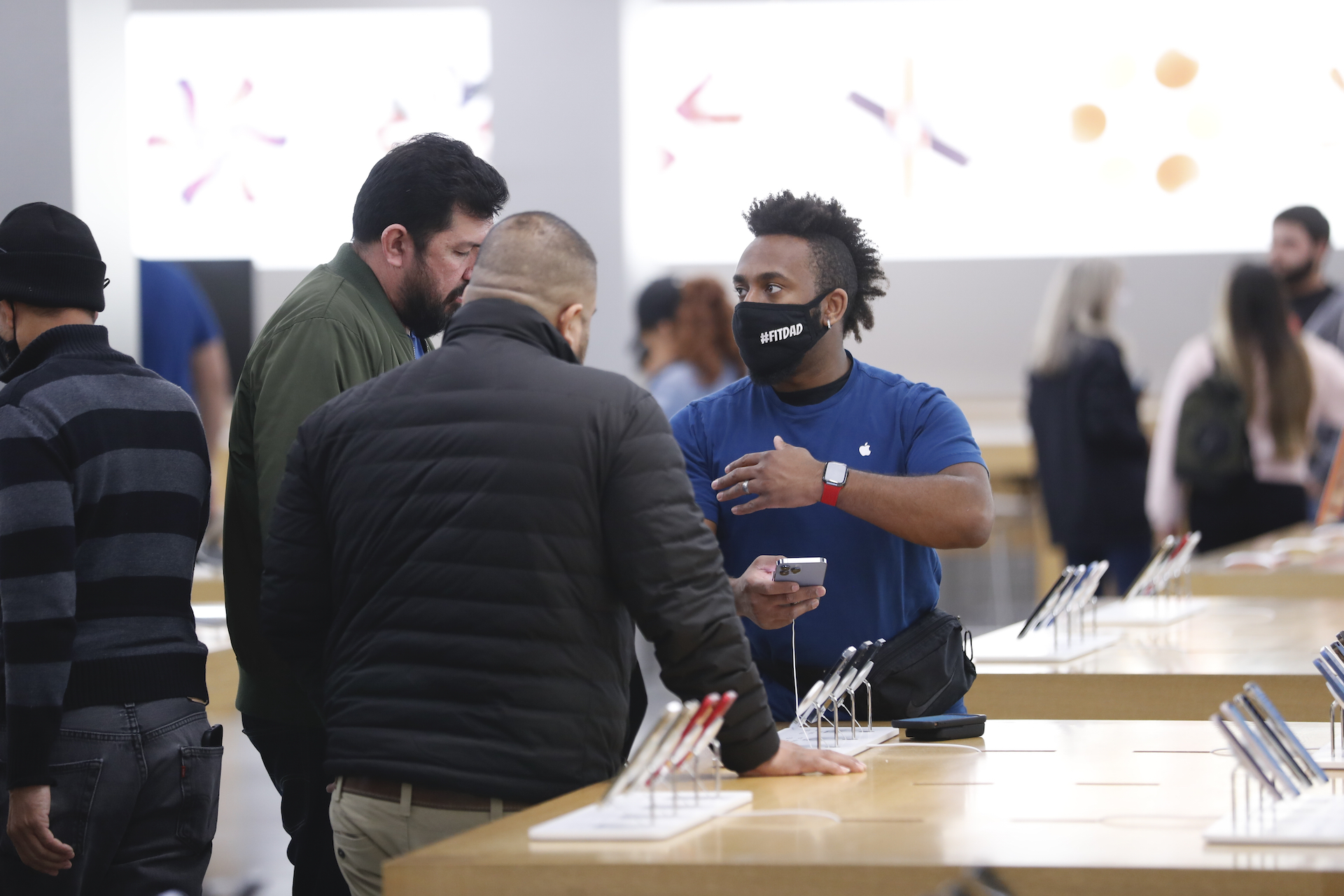Solving the Talent Challenge in Retail

An Apple store employee helps customers during Black Friday at International Plaza on November 26, 2021 in Tampa, Florida. Retail is still experiencing a labor shortage, even as other industries recover.
Photo: Octavio Jones/Getty Images
The labor shortage may be ending in many industries. For evidence, look at Uber, which attracted a record 5 million drivers in 2022. But there is one category where the problem remains stubbornly unsolved: retail. This is despite retailers’ best efforts to look after their employees by offering pay increases and improved benefits.
The Challenge
Recruitment, retention and productivity are grounded in how strongly employees find meaning from their employment. We found a 27 percentage-point difference in retention and a 37-point gap in revenue growth between companies that provide that meaning and those that do not.
Unsurprisingly, companies with experienced staff who feel a bond with their employer perform more strongly. Yet only 28% of companies are delivering that meaning, and retail on average underperforms other industries. While retail employees do recommend the products they sell, they are not inspired by what their organization stands for and do not believe their friends or family would be impressed by their job. They feel unsupported in their career growth and constrained by the lack of flexibility in the way that they work. Just as importantly, they do not understand how their role influences the company’s mission or feel that they have the tools or support to deliver it.
With greater turnover comes a less experienced workforce that has resulted in higher workers’ compensation claims, in contrast to country-wide declines of 5% to 10% per year. The labor market also remains tight, resulting in shallow labor pools that, in part, have resulted in pay compression. But increasing the total wage bill to buy employees’ loyalty is not the answer. Why? There just is not financial headroom as retail faces a range of challenges beyond labor — from supply chain disruption to investing in digital transformation and rising environmental, social and governance expectations.
The Opportunity
If we look to the travel and hospitality category, employees rate their compensation on par with retail. However, they perceive much greater meaning from their work, which means the value ratio of their employment is consistent with other industries, enabling travel businesses to better compete for talent. This is the opportunity in retail: Build stronger meaning in the employee value proposition with prospects and employees.
This can be done through surfacing a company’s inspiring mission and articulating how employees can contribute to it, ensuring compensation is balanced, creating supportive growth paths, and quickly responding to evolving workplace expectations, to name a few.
Create Inspiration
Marketing can be key in creating inspiration. With the growth of digital, amplified by the pandemic, the physical convenience provided by location is less of a competitive advantage than it was in the past. This has driven the need for retailers to transform into a destination, not only a provider of commodity products. In the past, marketing prioritized “performance marketing,” measured on immediate sales.
Creating a destination requires greater emphasis on brand marketing, driving belief and desire for the entire offer, the “why” behind the “what.” This will also help build pride and belonging among existing employees and consideration among prospects. HR can piggyback on this effort to help marketing consider the employee angle and then complement it with internal communications that highlight the employee’s personal role in delivering the mission.
Rebalance Compensation
Reliance on compensation benchmarks alone can result in a race to the middle because what everyone else is doing is unlikely to be right for your organization. It is critical to actively engage and listen to what keeps your employees up at night: inflation, health and safety concerns, the ability to care for dependents, and saving for retirement. These persistent fears make employees anxious, hindering their ability to be fully present at work. Total rewards can be realigned to ensure dollars are spent in the areas that matter most — and segmenting a workforce into personas with individualized offerings can help.
We have found particular benefits from reward programs that are directed to those needs most relevant to employees and demonstrate differentiation from competitors. For one global retailer, the waste identified was redeployed to address pay compression that was a key pain point for experienced staff. There was also a benefit from the process of being open and transparent, with increased trust in how compensation was determined, which led to a decrease in turnover.
Recognizing and celebrating diversity, whether LGBTQ, ethnicity or being a working parent, creates greater belonging and helps people be their authentic selves — something that aids productivity and is desired by customers.
It is true that the most valuable employees are typically those with personal drive. They care not only about the present, but how employers can help them on their career journey and the skills and responsibilities that they can master. Painting a bright future and providing substance on the pathways creates meaning through anticipation.
Adapt to Evolving Expectations
For many retailers, consistency has been a prime imperative for delivering the customer experience. However, many employees find that this consistency is a straitjacket they are no longer prepared to suffer. There are two primary dimensions to consider. The first is flexible working. The gig workforce doesn’t always want fixed hours at a fixed location. That presents a challenge in retail, but it is not necessarily insurmountable. Chick-fil-A has successfully instituted job-sharing through three-day blocks of shifts lasting 13 –14 hours.
Secondly, people want to feel that they can bring their whole self to work and not have to fit in with a homogenous corporate culture. Recognizing and celebrating diversity, whether LGBTQ, ethnicity or being a working parent, creates greater belonging and helps people be their authentic selves — something that aids productivity and is desired by customers. Successful corporate cultures benefit from working according to principles rather than rules. You can’t manage a thousand touchpoints with a manual.
Both Southwest and Delta are principles-based, enabling their employees’ freedom to meet customer demands during exigent circumstances — for example, ordering pizzas for stranded passengers. That they can do this within a heavily regulated and safety-first industry demonstrates that this can be achieved in almost any industry.
Optimize Recruiting Activities
Broadly speaking, the shift to digital means recruiters are looking for new skills — and that there is greater competitive intensity for certain skills. In fact, reskilling was the No.1 workforce initiative for executives in 2022. In that context, many of the tactics for recruiting are not as effective as they once were. There is a benefit from being specific on the skills needed, yet only 53% of companies have a skills taxonomy in place. A more effective pipeline may be built by identifying the most prevalent skills driving the compensation to secure top talent.
Better Manage Your Risk Profile
As we shared earlier, the change in workforce mix has introduced new risks that have seen insurance premiums rise in retail just as they are falling elsewhere. An active risk manager can lower premiums through targeted workplace training and safety programs. Effective pre-loss (safety) and post-loss (claims management) strategies and execution will routinely deliver significant savings that can be reinvested to support a more attractive employee value proposition.
One large national retailer used these analytics to identify underperforming distribution centers, implement a targeted safety and ergonomic program, and determine claims deserving early and aggressive intervention. The result was a 27% reduction in workers’ compensation costs over two years.
In Conclusion
With HR, marketing and risk working together to enhance the employee value proposition, we believe retailers can hire, retain and motivate top talent, even during these volatile times.
What is clear is that many retailers are not adapting sufficiently quickly to a talent market that has materially changed from before the pandemic. As an industry going through transformation, it is likely that other topics are monopolizing management attention. Yet strong talent is a prerequisite and foundation for everything. There has never been a more urgent time for retailers to solve this pressing challenge.






